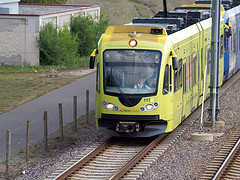
In 2010, the University of Minnesota’s Transitway Impacts Research Program released two studies of the impact of the Minneapolis light rail (“Hiawatha Line”) on real estate values. The residential study (pdf) estimated that houses near rail stations gained a total of $29.4 million more than houses outside the area, and multi-family properties gained a total of $17.7 million. The commercial/industrial study (pdf) estimates an increase of $20 per square foot (pdf) of building space, tho they do not extrapolate this to estimate the total impact. Assuming for the moment that the commercial/industrial impact (which includes much of downtown Minneapolis) is double the total residential impact, we have a total land value gain of $141 million.
Now, that’s a nice amount of money, but building and equipping the rail line cost $715 million in total tax money, and it seems per page 32 of this big pdf to require about $15 million in annual operating subsidy from taxes. Assuming the construction cost to be financed with bonds costing 4%, that’s an annual cost of about $44 million (in addition to fares collected.) Can this be justified by a land value increase of $141 million?
It’s a question worth asking, but there are reasons the answer may be “yes, easily.” First, a big shortcoming of the studies is that they compare prices before the line started operating, in 2004, with prices afterwards. It stands to reason, and has been established elsewhere, that real estate values start rising no later than the beginning of construction for a new rail transit line.
Second, real estate sales price may be the capitalized value of future expected net rent, after taxes, but is only indirectly related to gross rent. The difference is taxes, not only the real estate taxes collected against the parcel, but also other taxes which operate to reduce rent. Thus, increased real estate tax, sales tax, state income tax, and other taxes which may occur as a result of the transit line should be recognized as a benefit which the community receives (and collects!).
Finally, the studies look only at the localized effects within a mile of the station. Of course the greatest concentration of benefits will be found in this area, but a small percentage value increase regionwide, which could result from the rail line, could sum to a large amount but would not show up in these studies.
In conclusion, it is certainly possible that the community benefit of the Hiawatha Line, as measured by actual land value, far exceeds the cost of building and operating the facility. Unfortunately, these studies do not actually test the proposition.
None of this is to say that transit investment always increase land value. A project whose main purpose is to provide jobs and contracts, with little transportation benefit, might cost far more than the resulting increase in land values (if any).
Thanks to Bill Batt for the lead to these studies.